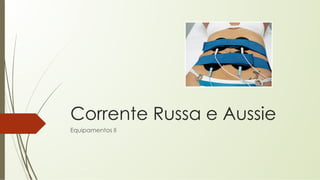
AULA_04.pdf
- 1. Corrente Russa e Aussie Equipamentos II
- 2. Corrente Russa É uma corrente usada para o fortalecimento muscular. Fisiologista russo Yadov Kots (anos 70-80) As primeiras citações sobre corrente russa aconteceram quando os astronautas de uma estação orbital soviética utilizaram a corrente para estimular a musculatura que ficava hipotônica/hipotrófica por causa da ausência de força da gravidade Em 1982, as atletas de ginástica olímpica da equipe soviética utilizaram a corrente russa dias antes das provas para aumentar a força muscular
- 3. Corrente Russa É uma corrente de média frequência de 2.500 Hertz Corrente despolarizada, pois não apresenta polos definidos De acordo com Agne (2006), trata-se de um trem de impulsos emitidos numa frequência de 2.500Hz modulada por uma onda que pode variar de 50 a 80Hz
- 4. Corrente Russa Além disso, é um tipo de corrente seletiva, pois podemos trabalhar tanto fibras musculares vermelhas ou do tipo I, quanto fibras musculares brancas ou do tipo II A corrente vai estimular a contração muscular
- 5. Corrente Russa Fibras musculares tipo I: fibras de contração lenta - Possuem grande suprimento vascular - Grande quantidade de mitocôndrias - São resistentes à fadiga - Possuem baixa produção de força - Exemplo: maratonistas, ciclistas, nadadores de longa distância - Estimuladas na frequência de 20 a 30Hz
- 6. Corrente Russa Fibras musculares tipo II: fibras de contração rápida - Possuem baixo suprimento vascular - Baixa quantidade de mitocôndrias - São pouco resistentes à fadiga e possuem grande produção de força - Exemplo: atividades de velocidade e explosão - Estimuladas na frequência de 50 a 150Hz
- 7. Corrente Russa Tipo I: recrutadas nas atividades cotidianas Tipo II: pouco recrutadas no cotidiano Contração voluntária: 1° fibras tipo I (lentas) 2° fibras tipo II(rápidas) Contração elétrica: 1° fibras tipo II (rápidas) 2° fibras tipo I (lentas)
- 8. Indicação Auxilia no fortalecimento e definição muscular Aumento da irrigação sanguínea Aumento do retorno sanguíneo e linfático
- 9. Contraindicações Cardiopatias Portadores de marca-passo Doenças circulatórias Pressão arterial descompensada Neoplasias Doenças pulmonares Renais crônicos Processos infecciosos e inflamatórios Lesões musculares Implante ou prótese metálica Epilepsia Gestação Dermatite ou dermatoses Pacientes neurológicos (tônus alterado) Fraturas ósseas recentes Excesso de tecido adiposo (isolante)
- 10. X Russa Frequencia: 2500Hz intervalo de pulso: 10m/s Aussie frequência de 1kHz(estimulação motora) e 4kHz (analgesia e drenagem) intervalo de pulso 2 ou 4 m/s Mais confortável
- 11. Parâmetros para aplicação Tempo: - Média de 20 minutos para sedentários - De 25 a 30 min com a evolução do tratamento ou se já realizam atividade física Posicionamento dos eletrodos: sobre os pontos motores, nos ventres musculares - Manter contato firme e uniforme com a pele - Higienizar a pele (diminuir a impedância) - Permitir a movimentação adequada
- 15. Parâmetros para aplicação Tempo de subida (rise): 1ª 5 seg Tempo de descida (decay): 1ª 5 seg Tempo ON: 6s (contração) Tempo OFF: 6s (repouso) A intensidade ideal é a máxima tolerada com conforto pelo paciente - Durante a sessão vai havendo acomodação, sendo necessário ajustá-la gradativamente, tomando cuidado de fazê-la sempre no tempo on, fase de contração Os resultados podem ser potencializados se associada a contração ativa
- 16. Parâmetros para aplicação Frequência portadora -1kHz Duração dos Bursts(pulsos) - 2ms Frequência de modulação dos Bursts - 50Hz Modo: síncrono